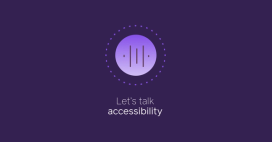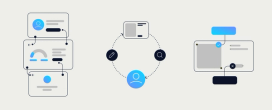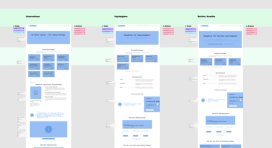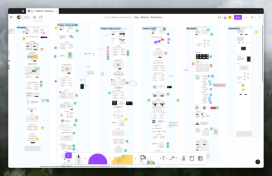- Business
- Accessibility
- User Research
- Qualitative Research
- Human Connections
Good Design is Accessible


Think of a someone who is colourblind and struggles telling the difference between specific colours, an elderly person who suffers from near sightedness and a busy mom of 3 kids under 10 who needs to send a text message whilst juggling the needs of her fidgeting kids. They all call for accessible assistive technology to varying degrees.
The first person requires their device to have High Contrast Mode.
The elder requires Screen Magnification software on their device
The busy mom requires speech-to-text assistance technology.
In today's digital age, the concept of accessibility has transcended beyond mere compliance with regulations, it has become synonymous with good design. Accessible design prioritizes inclusion by ensuring that all individuals, regardless of their abilities or disabilities, can access and interact with digital products seamlessly. Digital participation is not optional anymore it has evolved from a choice to a necessity within our modern society. Whether it's for communication, work, education, or even leisure our involvement in digital spaces has become deeply ingrained in our daily routines. This ubiquity underscores the critical role that accessibility plays in the digital space . As we embrace digitalisation as an essential arena for productivity and connection, ensuring that it is accessible to all individuals regardless of ability or circumstance becomes paramount.
As product teams, it is our job to empathise with the user and create products that they love. Accessibility in design is a form of empathy: trying to reach beyond your own personal perspective to try to understand other people who don’t see the world the same way you do.
What is accessibility
Accessibility in the UX context is described as ensuing that all the members of the target audience group have equal access to the product or service. It also means that the design is usable and useful in multiple settings, meeting the varying needs of users. It is often thought that accessibility deals only with people who have special needs, but this is not the sole purpose. When it comes to the design of a product or service, accessibility refers to all the ways in which a design can be made more useful. This can include special physical needs and also the context in which a product is being used. For example, light and dark mode can be used for people with visual impairments additionally it is used for mobile devices in the glaring sun. This example illustrates how accessibility design is for everyone. Catering to both physical needs and contextual needs.
Accessibility research serves as the cornerstone for designing products that cater to diverse user needs. By understanding the challenges faced by different individuals with permanent disabilities and/or situational/environmental hinderances, businesses can proactively identify barriers and devise solutions that meet ALL users needs, making the product more appealing to the consumer.
Why is accessibility important
Any business that isn’t reaching a diverse market is missing out on enormous revenue potential and the opportunity to build products that suit their users' core needs. When products take into account all its diverse user needs the product is able to better match and appeal to the user. Products built accessibly are inherintly good design that benefits all. Take for example the the sidewalk cross slope was implemented as part of accessible design specifically for wheelchair users. However it benefits all users in their day to day life. Parents with prams, shoppers with shopping carts, the elderly who have trouble climbing up elevated surfaces and the list goes on. By prioritising accessible design we prioritise all users and open up the market to broadening target audiences.
How prioritising accessibility directly improves user experience
To truly embrace accessible design principles, it is imperative to integrate accessibility considerations into every stage of the design process. From ideation and prototyping to implementation and testing, accessibility should be treated as a fundamental aspect of design rather than an afterthought. Product teams should leverage tools and guidelines such as the Web Content Accessibility Guidelines (WCAG) and the Accessible Rich Internet Applications (ARIA) specification to ensure compliance with accessibility standards and create intuitive user experiences for everyone.
The world is designed for the 80% of people who are able-bodied. Often making tasks tedious or even impossible for those with different needs. This that would be easy to solve if our product teams just looked a bit wider than our own myopic experiences and understood disabled peoples needs. By improving products and services for the 20% actually improves things for the 80% too. When you design for people with the most extreme needs you make life better for everyone.
How to user test to ensure accessibility
Usability testing plays a pivotal role in validating the effectiveness of accessibility features and ensuring a seamless user experience for individuals with disabilities. By involving users with diverse abilities in usability testing sessions, designers can gather real-world feedback on the accessibility of their products. This iterative process allows for the identification of usability barriers and the refinement of design solutions to better meet the needs of all users. Moreover, usability testing serves as an opportunity to educate stakeholders about the importance of accessibility and its impact on user satisfaction and retention.
Here are some User Testing guidelines provided by Digital Scientists
- Recruiting a larger number of participants: Different users might share a diagnosis but have completely different experiences. Testing with a bigger number of participants takes into account the array of experiences.
- Establish community partners: By establishing connections with community partners with the necessary expertise to cater to their community’s unique requirements.They have key informational materials that help our education, they also have specialists to go to for support and consulting, and often have assistive technology specialists on hand who can provide us with additional support when testing products in a usability test.
- Prioritise an accessible user testing experience for participants: ensure that participants have all they need to allow for a smooth experience. Take into account the location, communication needs and time flexibility.
- Maintain privacy information: During usability tests, participants may share personal and sensitive information, such as private health information, personal stories, or sometimes protected data.
- Be open to critique: One of the things we enjoy the most about accessibility testing is opening ourselves up to receive critique, as it allows us to improve our products and testing methods. We can improve our products and testing methods by listening to user feedback to meet diverse needs better.
Conclusion
Accessible design is not just a legal requirement; it is a fundamental principle of good design. By prioritizing accessibility research and usability testing, product teams and businesses at large can create products that empower all users to participate fully in the digital world. Embracing accessibility as a core design tenet not only fosters inclusivity but also enhances user satisfaction, fosters innovation, and expands market reach. As we continue to strive for a more inclusive society, let us remember that accessible design is not just about meeting standards; it is about embracing diversity and going above and beyond to unlock the full potential of technology for everyone.





